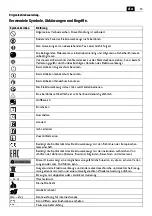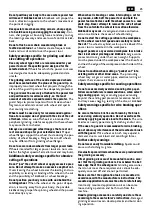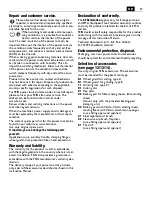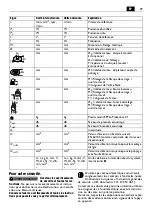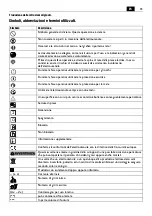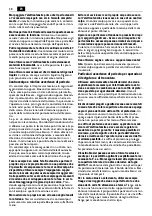
26
en
When using application tools with a threaded insert,
take care that the thread in the application tool is long
enough to hold the spindle length of the power tool. The
thread in the application tool must match the thread on
the spindle.
Incorrectly mounted application tools can
loosen during operation and cause injuries.
Do not direct the power tool against yourself, other per-
sons or animals.
Danger of injury from sharp or hot
application tools.
Beware of any concealed electric cables, gas or water
conduits.
Check the working area before commencing
work, e. g. with a metal detector.
Use a stationary extraction system, blow out ventilation
slots frequently and connect a residual current device
(RCD) on the line side.
When working metal under
extreme operating conditions, it is possible for conduc-
tive dust to settle in the interior of the power tool. The
total insulation of the power tool can be impaired.
Do not rivet or screw any name-plates or signs onto the
power tool.
If the insulation is damaged, protection
against an electric shock will be ineffective. Adhesive
labels are recommended.
Always work with the auxiliary handle.
The auxiliary
handle ensures reliable guiding of the power tool.
After working gypsum-containing materials: Blow out
the ventilation openings of the power tool and the
switch element with dry and oil-free compressed air.
Otherwise, gypsum-containing dust can settle in the
power tool housing and switch element, which can
harden in connection with humidity. This can impair the
switching mechanism.
Before putting into operation, check the mains connec-
tion and the mains plug for damage.
Recommendation: The tool should always be supplied
with power via a residual current device (RCD) with a
rated current of 30 mA or less.
Hand/arm vibrations
The vibration emission level given in this information
sheet has been measured in accordance with a stand-
ardised test given in EN 60745 and may be used to
compare one tool with another. It may be used for a
preliminary assessment of exposure.
The declared vibration emission level represents the
main applications of the tool. However, if the tool is
used for different applications, with different accesso-
ries or poorly maintained, the vibration emission may
differ. This may significantly increase the exposure level
over the total working period.
An estimation of the level of exposure to vibration
should also take into account the times when the tool
is switched off or when it is running but not actually
doing the job. This may significantly reduce the expo-
sure level over the total working period.
Identify additional safety measures to protect the oper-
ator from the effects of vibration such as: maintain the
tool and the accessories, keep the hands warm, organi-
sation of work patterns.
Handling hazardous dusts
For work procedures with this power tool where
material is removed, dusts develop that can be hazard-
ous to one’s health.
Contact with or inhaling some dust types, e. g. asbestos
and asbestos-containing materials, lead-containing coat-
ings, metal, some wood types, minerals, silicate parti-
cles from materials containing stone, paint solvents,
wood preservatives, antifouling paints for vessels, can
trigger allergic reactions to the operator or bystanders
and/or lead to respiratory infections, cancer, birth
defects or other reproductive harm. The risk from
inhaling dusts depends on the exposition. Use dust
extraction matched appropriately for the developing
dust, as well as personal protective equipment and pro-
vide for good ventilation of the workplace. Leave the
processing of asbestos-containing materials to special-
ists.
Wood and light-metal dust, hot mixtures of grinding
dust and chemical materials can self-ignite under unfa-
vourable conditions or cause an explosion. Avoid
sparking in the direction of the dust collector as well as
overheating of the power tool and the materials being
sanded, empty the dust collector/container in time,
observe the material manufacturer’s working instruc-
tions, as well as the relevant regulations in your country
for the materials being worked.
Operating Instructions.
Press the locking button only when the motor is
stopped (see page 5). Otherwise the power tool
may be damaged.
Features
The
soft start
is used to reduce torque reaction forces
when switching on and running up the power tool to
the no-load speed.
The
restarting protection
prevents the power tool from
automatically restarting if the power supply is inter-
rupted during operation. In this case, switch off the
power tool, check the power supply and then switch
the power tool on again.
The
blocking monitor
reduces the risk of motor damage
and the risk of accidents when an application tool
blocks. In this case, the power tool switches off auto-
matically. Afterwards, set the switch to the off position,
remove the power tool from the workpiece and check
the application tool for damage. Afterwards, switch the
power tool on again.
The
electronic speed preselection
enables the speed to
be adapted to the respective application and the respec-
tive application tool.
The
kickback monitoring
reduces the risk of unex-
pected kickback of the power tool. In this case, the
power tool switches off automatically. Afterwards, set
the switch to the off position, remove the power tool
from the workpiece and check the application tool for
damage. Afterwards, switch the power tool on again.
Summary of Contents for 7 222 80 60 00 0
Page 1: ...CG13 125V 7 222 CG17 125 7 222 CG17 125INOX 7 222 CG17 150 7 222 ...
Page 3: ...3 6 5 10 11 9 8 4 7 4 9 ...
Page 4: ...4 2 1 2 3 1 ...
Page 5: ...5 1 3 4 2 2 4 3 1 ...
Page 6: ...6 2 1 ...
Page 7: ...7 1 2 ...
Page 8: ...8 2 1 2 1 1 1 3 1 ...
Page 10: ...10 1 1 1 0 mm 1 3 3 3 2 2 3 ...
Page 11: ...11 ...
Page 12: ...12 B 1 1 1 3 1 4 1 A 1 2 1 4 1 ...
Page 13: ...13 3 2 3 3 4 2 5 1 ...




